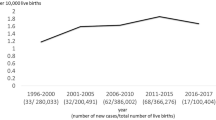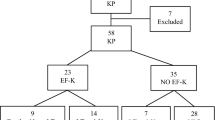Abstract
Purpose
Kasai portoenterostomy (KP) is the primary procedure for biliary atresia (BA). However, due to reports of poor outcomes of KP, primary liver transplantation (LT) is preferred in selected cases. In Japan, primary LT is limited with no study reports details, particularly regarding the indications. We conducted the first nationwide survey to assess the status of primary LT in Japan.
Methods
Questionnaires were sent to institutions where procedures other than KP were performed as the initial procedure for BA and registered to the Japan Biliary Atresia Registry. Parameters related to procedure selection were analyzed.
Results
Of 2895 patients registered (1989–2013), primary LT (n = 15) or exploratory laparotomy (EL) followed by LT (n = 9) without KP was performed in 24 cases (0.8%). The main reason for primary LT was late diagnosis, and for EL followed by LT, lack of fibrous tissue at the porta hepatis (ο-type). The prognoses of LT without KP was good.
Conclusion
Non-KP initial procedures were limited. Clear criteria regarding the timing of diagnosis or patient condition could not be determined. Reasons for not initially selecting KP varied, but late diagnosis was predominant. Further study is needed to create guidelines for the initial treatment of BA patients.


Similar content being viewed by others
References
Shinkai M, Ohhama Y, Take H, Kitagawa N, Kudo H, Mochizuki K, Hatata T (2009) Long term outcome of children with biliary atresia who were not transplanted after the Kasai operation. %3e 20-year experience at a children’s hospital. J Pediatr Gastroenterol Nutr 48:443–450
Nio M (2017) Japanese biliary atresia registry. Pediatr Surg Int 33:1319–1325
Nio M, Wada M, Sasaki H, Tanaka H (2015) Effects of age at Kasai portoenterostomy on the surgical outcome: a review of the literature. Surg Today 45:813–818
Superina R (2017) Biliary atresia and liver transplantation: results and thoughts for primary liver transplantation in select patients. Pediatr Surg Int 33:1297–1304
Schoen BT, Lee H, Sullivan K, Ricketts RR (2001) The Kasai portoenterostomy: when is it too late? J Pediatr Surg 36:97–99
Bielamowicz A, Weitzman JJ, Alshak NS, Rosenthal P (1992) Successful late Kasai portoenterostomy. J Pediatr Gastroenterol Nutr 14:232–236
Nizery L, Chardot C, Sissaoui S, Capito C, Henrion-Caude A, Debray D, Girard M (2016) Biliary atresia: clinical advances and perspectives. Clin Res Hepatol Gastroenterol 40:281–287
Serinet MO, Wildhaber BE, Broué P, Lachaux A, Sarles J, Jacquemin E, Gauthier F, Chardot C (2009) Impact of age at Kasai operation on its results in late childhood and adolescence: a rationale basis for biliary atresia screening. Pediatrics 123:1280–1286
Sandler AD, Azarow KS, Superina RA (1997) The impact of a previous Kasai procedure on liver transplantation for biliary atresia. J Pediatr Surg 32:416–419
Neto JS, Feier FH, Bierrenbach AL et al (2015) Impact of Kasai portoenterostomy on liver transplantation outcomes: a retrospective cohort study of 347 children with biliary atresia. Liver Transpl 21:922–927
Japanese Biliary Atresia Society Workshop (2017) Biliary atresia national registration 2015 count result. J Jpn Soc Pediatr Surg 53:319–325 (in Japanese)
Baruah RR, Bhatnagar V, Agarwala S, Gupta SD (2015) Correlation of pre- and post-operative liver function, duct diameter at porta hepatis and porta fibrosis with surgical outcomes in biliary atresia. J Indian Assoc Pediatr Surg 20:184–188
Eurotransplant International Foundation. Statistics Report Library. Liver transplants in 2018, by country, by donor type, by organ combination. https://statistics.eurotransplant.org/. Accessed 10 Aug 2019
Japanese Biliary Atresia Society Workshop (2016) Biliary atresia national registration 2014 count result. J Jpn Soc Pediatr Surg 54:307–313 (in Japanese)
Japanese Biliary Atresia Society Workshop (2000) Biliary atresia national registration 1998 count result. J Jpn Soc Pediatr Surg 36:348–353 (in Japanese)
Japanese Biliary Atresia Society Workshop (2015) Biliary atresia national registration 2013 count result. J Jpn Soc Pediatr Surg 51:268–274 (in Japanese)
Acknowledgements
We would like to express our sincere gratitude to the Japan Biliary Atresia Society for supplying the registry data. In addition, we are deeply thankful for the cooperation of the institutions and the pediatric surgeons in gathering the patient data; Dr. Tatsuya Suzuki from Fujita Health University, Dr. Shigeru Ono from Jichi Medical University, Dr. Masato Shinkai from Kanagawa Children's Medical Center, Dr. Hideaki Okajima from Kyoto University, Dr. Taizo Furukawa from Kyoto Prefectural University of Medicine, Dr. Toshiharu Matsuura from Kyushu University, Dr. Mikihiro Inoue from Mie University, Dr. Akihide Tanano from Nagoya University, Dr. Satoshi Kondo from Nagoya City University, Dr. Mureo Kasahara from National Center for Child Health and Development, Dr. Kengo Nakaya from Niigata University, Takehisa Ueno from Osaka University, Dr. Hiroaki Kitagawa from St. Marianna University School of Medicine, Dr. Hiromu Tanaka from Tohoku University. We would like to thank Editage (https://www.editage.com) for English language editing.
Funding
None.
Author information
Authors and Affiliations
Corresponding author
Ethics declarations
Conflict of interest
The authors declare that they have no conflict of interest.
Ethical approval
All procedures performed in studies involving human participants were in accordance with the ethical standards of the institutional research committee (Kumamoto University Hospital IRB #827) and with the 1964 Helsinki declaration and its later amendments or comparable ethical standards.
Additional information
Publisher's Note
Springer Nature remains neutral with regard to jurisdictional claims in published maps and institutional affiliations.
Rights and permissions
About this article
Cite this article
Uto, K., Inomata, Y., Sakamoto, S. et al. A multicenter study of primary liver transplantation for biliary atresia in Japan. Pediatr Surg Int 35, 1223–1229 (2019). https://doi.org/10.1007/s00383-019-04553-7
Accepted:
Published:
Issue Date:
DOI: https://doi.org/10.1007/s00383-019-04553-7




